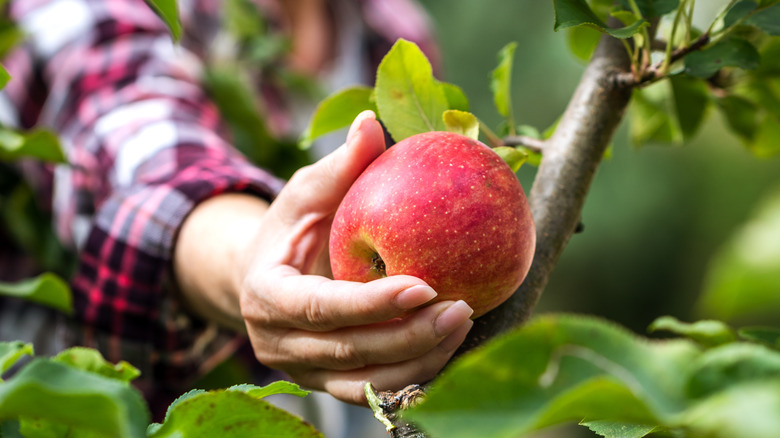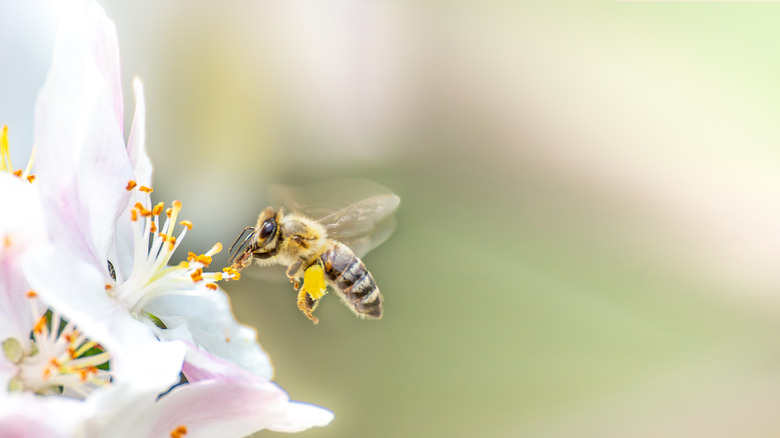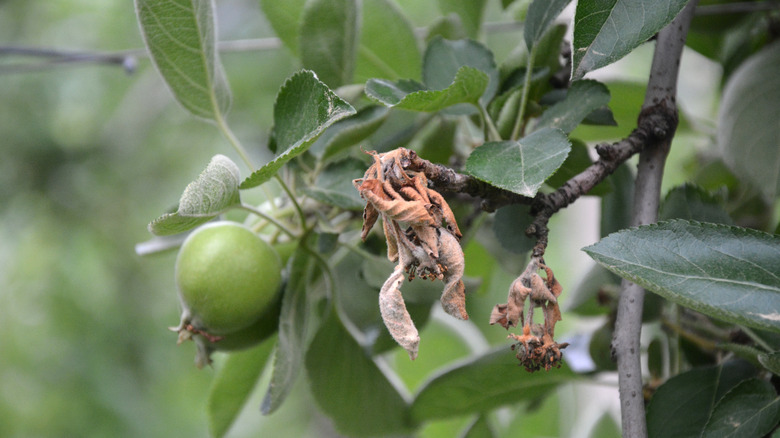Which Apple Blossom Flowers Are Going To Produce The Largest Fruit In Your Garden?
If you're ever asked to bet on which apple blossom from your tree will grow the biggest fruit, you'll want to place your dollar on the king blossom. This blossom, in particular, is known to grow the largest apple of all the surrounding buds. There are two types of buds: terminal and lateral. Terminal buds are found at the shoot tip, while lateral buds form closer to the leaf blade on a developing shoot. The king apple blossom is the center bud among the usual four to six that are attached to shoot tips or the short branches of the tree, called a "bourse."
From the cluster of buds, the king flower opens first. Healthy apple blossoms, or king blossoms for that matter, don't magically appear though. The apple tree goes through phases of growth after it flowers that contribute to fruit development, and it must remain unscathed from disease to reach its full potential. One key phase for apple growth, in particular, is pollination.
The importance of pollinating the king blossom
The king blossom needs to be pollinated to ensure it grows prized fruit. Without adequate pollination or when only one side of the blossom's ovules is pollinated, the king blossom may provide distorted apples. Similarly, when apple blossoms aren't properly fertilized after pollination, the blossoms shrivel and fall off, unable to bear fruit. The blossoms shed by the apple tree depends, again, on how many ovules are fertilized.
The order in which apple blossoms open displays the intelligence of Mother Nature herself. This is because not all of the apple blossoms open at the same time. The staggered blooming times extend the pollination period. After the king blossom blooms, the smaller blossoms in the cluster open one by one to reveal various stamens with anthers that produce pollen used by pollination insects. It's important that the king blossom is pollinated as soon as possible because it's only receptive to pollination for a short time compared to the rest of the cluster.
Luckily, there are some things you can do to enhance proper pollination of your king blossom. First, pollinating insects are critical to apple development since apples can't self-pollinate. Because of this, be careful using pesticides that can harm or prevent bees from visiting your blossoms. It's also important to have another variety of apple tree available to allow for cross-pollination. Flowering crabapples are a highly recommended variety because they bloom for longer and are easy to care for.
Beware of fire blight
As crucial as pollination is, knowing what diseases your apple blossoms are vulnerable to is equally important. Fire blight is a bacterial disease that can kill blossoms and shoots. A tell-tale sign your tree is infected with fire blight is the appearance of water-soaked apple blossoms that wilt and turn brown. Blossoms are typically affected in the spring when insects can carry the bacteria into the newly opened flower. Three conditions are usually present for fire blight to take hold: rainfall, warm weather, and blooming time.
Managing a fire blight outbreak during the growing season is challenging. Pruning diseased shoots and branches during an active growing season is problematic because the live bacteria can spread more easily. This puts your current tree and future crops at risk. With this in mind, if you need to prune during the growing season, here are some suggestions: Prune twigs 6 to 12 inches below the infection, disinfect your tools, don't prune when the tree is wet, and immediately dispose of infected parts.
The good news is you won't have to undergo the trouble above if you focus on fire blight prevention from the get-go. A simple way to increase your chances of preventing a fire blight outbreak is by planting resistant varieties. Cornell University lists Melrose, NovaEasyGro, and Priscilla among those highly resistant. Also, avoid over-fertilizing and excessive pruning. Only prune your tree enough to provide proper air circulation. This will ensure your apple blossoms grow as healthy and large as they are able.


